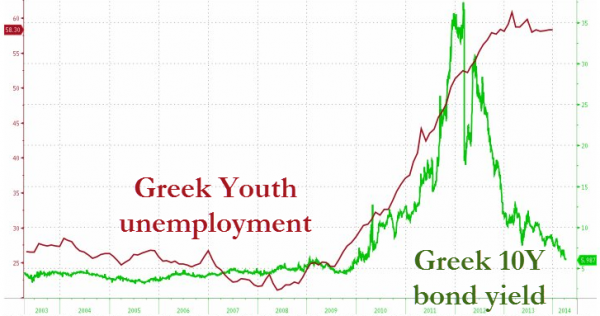For the first time since the bailout/restructuring, Greece will issue long-term debt to the public markets. These 5 year-term English Law bonds (which is entirely unsurprising given the total lack of protection local-law bonds suffered during the last restructuring) are expected to yield between 5 and 5.25%. That is modestly higher than Russia, below Mexico, and one-sixth of the yield investors demanded when the crisis was exploding. The secondary market has rallied to this entirely liquidity-fueled level leaving onlookers stunned (and likely Draghi et al. also).Greece must be ‘fixed’ right? Just don’t look at the chart below…
Greece is rated Caa3 by Moody’s Investors Service and B- by Standard & Poor’s Corp. and Fitch Ratings.
The commotion is US capital markets over huge IPO gains which are due more than anything to very small floats and major ‘get rich quick’ demand can also be found here as the issuance size is minimal leaving a world of yield chasers spying a European nation offering yields over 5% that is currently not rioting…

Â
Claims that is the best example of positive sentiment and of a new normal are foolish – if nothing else, this is a sign of utter complacency and exuberance.
As WSJ reports, Greece is anything but fixed…
Even with the prospect of a recovery in sight, Greece’s economy is still in pain.Since its precrisis peak in 2008, the Greek economy has shrunk by a quarter in size, unemployment is at a staggering 27.5%, and standards of living—made worse by successive government cutbacks—have gone back by a decade or more.
On Tuesday, Greece’s two public sector umbrella unions—GSEE and ADEDY—staged yet another general strike over Greece’s austerity program, shuttering public sector services across the country.
We’ll leave it to BofA’s John Wraitch to sum it up…
“It seems everything is bulletproof even when you do get relatively bad news; people are prepared to look straight through it,â€
“People are still hunting for yield and in the absence of any more material rise in safe-haven yields that means turning to bond markets that a more rational evaluation might lead you to be cautious about.â€

